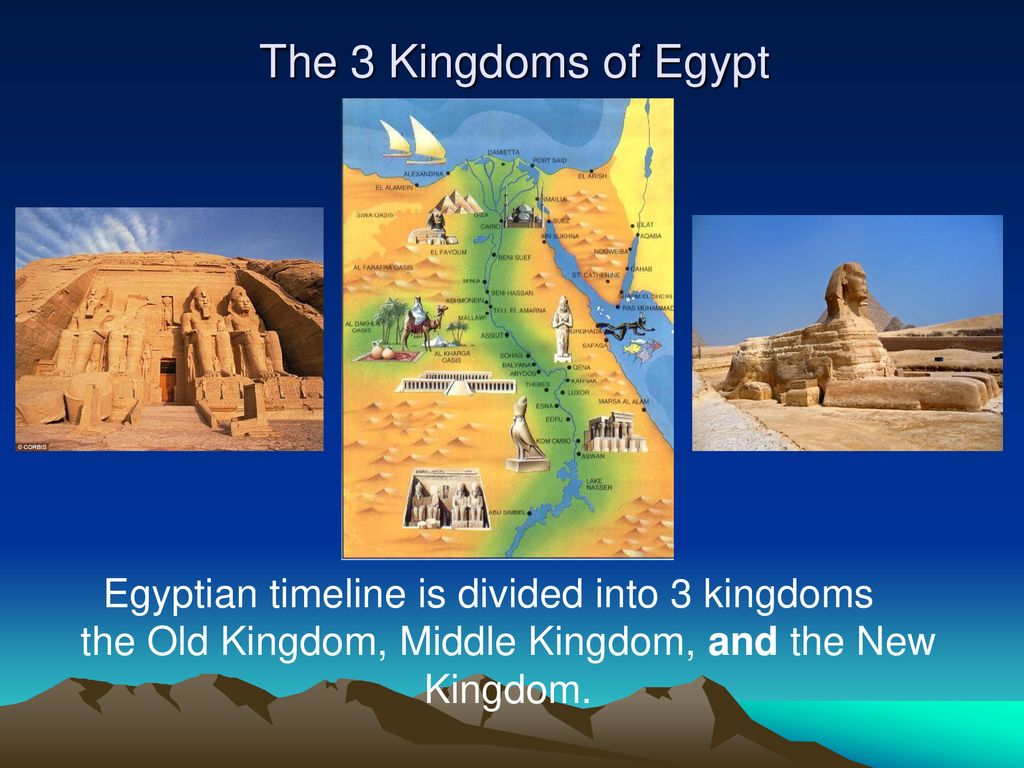As each Egyptian king died, a great sepulchral monument, often in the form of a pyramid, told his subjects that he had gone to join his predecessors in the community of gods. The largest of the pyramids took several generations to build and involved the continual labor of thousands of men. A highly centralized bureaucracy carried out the commands of the king. A stratified society worked for him. His forces advanced at times westward into the Libyan desert, and at other times eastward and northward into Palestine.
The Old Kingdom was first disturbed and eventually shattered by a growing tendency among district governors to pass their offices on to their sons, who in turn tended to regard themselves as hereditary rulers and thus to weaken the central authority. The priests of the sun had also made good their claims to special privileges that helped diminish royal power. After a disorderly interval of perhaps two centuries, a new dynasty restored unity in what is known as theMiddle Kingdom (2134-1786), distinguished for its rulers’ land-reclamation policies and its victories abroad.
To the south hostile Nubians were defeated, and their movements were controlled by the building of frontier fortresses. Palestine and Syria came under Egyptian influence. Bureaucracy flourished. Thebes ceased to be the capital, as a new city was founded south of Memphis, from which government could be exercised more effectively. Provincial governorship became hereditary but had to be confirmed by the king, and the king’s son at the age of twenty-one became co-ruler with his father.
Secessionist movements and growing internal weakness combined with a foreign invasion and conquest to put an end to the Middle Kingdom. The conquerors were Hyksos, Asian nomads of uncertain Amorite origin who imported the horse-drawn war chariot and perhaps the bow. The Egyptians hated their rule, which lasted about a century, and eventually rallied behind a new dynasty to drive out the invaders. By about 1558 the task was accomplished and the New Kingdom (1575-1087) was solidly established.*
The five centuries of the New Kingdom saw extraordinary advances. The Egyptians engaged in a struggle for Syria and Palestine, not only with the great powers of Mesopotamia but also with the mountain and desert peoples who lived between the two great valley civilizations. The Egyptian ruler (now called pharaoh) Thutmose I reached the Euphrates on the east and marched far south into Nubia. Thutmose III (c. 1469-1436) fought seventeen campaigns in the east, crossing the Euphrates to defeat his Mesopotamian enemies on their own soil. The walls of the great temple of Karnak preserve the carved account of his military achievements and the record of the enormous tribute paid him by his conquered enemies. The Egyptians established their own network of local governors throughout the conquered territories, but ruled mildly, and did not deport whole masses of the population into slavery. Nonetheless, the eighteenth dynasty embarked on a vast building program that depended on a ready supply of forced labor.
It was the pharaoh Amenhotep IV (r. 1364-1350) who caused a major internal upheaval in the successful New Kingdom by challenging the priests of the sun god Amen, who had become a powerful privileged class. Amenhotep urged the substitution for Amen of the sun disk, Aten, and, even more dramatic, commanded that Aten alone be worshiped and that the multitude of other gods be abandoned. Accordingly, Amenhotep changed his name to Akhenaten (Pleasing to Aten) in honor of his only god. Some have seen in this famous episode an effort to impose monotheism on Egypt. To mark the new policy, Akhenaten and his beautiful wife, Nefertiti, ruled from a new capital in Amarna. Nearby, beginning about A.D. 1880, were found the famous Tell-el-Amarna letters, a collection of about four hundred tablets including the diplomatic correspondence in many languages of Akhenaten and his father with the rulers of western Asia.
Akhenaten’s effort to overthrow the entrenched priesthood led to internal dissension and the loss of external strength. His son-in-law, Tutankhamen (r. 1347-1338 B.C.), was eventually sent to rule in Thebes, city of the priests of Amen, with whom he compromised. With Akhenaten’s death, the new religious experiment collapsed. About 1300 B.C. Ramses II concluded a treaty with the Hittites. This treaty, of which we have texts in both Egyptian and Hittite, called for a truce in the struggle for Syria and provided for a dynastic marriage between the pharaoh and a Hittite princess.
The interlude was short, however, and soon after 1200 B.C. the New Kingdom suffered an invasion of its eastern Mediterranean shores by mixed bands of raiders from the sea, sometimes called the Sea Peoples. Egypt entered into a decline, marked by renewed internal struggles for power between the secular authorities and the priests, and among localand central rulers. Then came the Assyrian conquest of the seventh century, the Persian conquest of 525 B.C.,and the conquest by Alexander the Great of Macedonia in 332 B.C.

